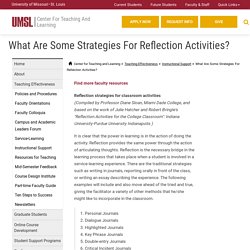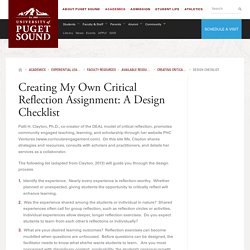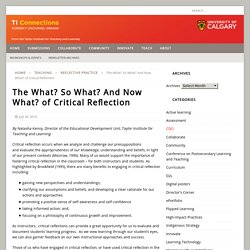

Reflection Activities for the College Classroom. What Are Some Strategies For Reflection Activities? Find more faculty resources Reflection strategies for classroom activities (Compiled by Professor Diane Sloan, Miami Dade College, and based on the work of Julie Hatcher and Robert Bringle's "Reflection Activities for the College Classroom": Indiana University-Purdue University Indianapolis ) It is clear that the power in learning is in the action of doing the activity.

Reflection provides the same power through the action of articulating thoughts. Reflection is the necessary bridge in the learning process that takes place when a student is involved in a service-learning experience. There are the traditional strategies such as writing in journals, reporting orally in front of the class, or writing an essay describing the experience. 1. . ( A note about reflection journals: a common tendency is for journal entries to become a mere log of events rather than a reflective activity in which students consider the service experience in the context of learning objectives. 1. 2. 3. 4. 5. 6. 7. 8. ST Reflection Toolkit. Design Checklist · University of Puget Sound. Patti H.

Clayton, Ph.D., co-creator of the DEAL model of critical reflection, promotes community engaged teaching, learning, and scholarship through her website PHC Ventures (www.curricularengagement.com). On this site Ms. Clayton shares strategies and resources, consults with scholars and practitioners, and details her services as a collaborator. The following list (adapted from Clayton, 2013) will guide you through the design process. Identify the experience. References Clayton, Patti H., PhD. (2013) "10 Tips for Designing Critical Reflection. " ReflectiveEssay PromptChecklist. What is a Critical Reflection? Introducing the “What, So What, Now What” Model.
The What? So What? And Now What? of Critical Reflection. By Natasha Kenny, Director of the Educational Development Unit, Taylor Institute for Teaching and Learning Critical reflection occurs when we analyze and challenge our presuppositions and evaluate the appropriateness of our knowledge, understanding and beliefs, in light of our present contexts (Mezirow, 1990).

Many of us would support the importance of fostering critical reflection in the classroom – for both instructors and students. As highlighted by Brookfield (1995), there are many benefits to engaging in critical reflection including: gaining new perspectives and understandings; clarifying our assumptions and beliefs, and developing a clear rationale for our actions and approaches; promoting a positive sense of self-awareness and self-confidence taking informed action; and, focusing on a philosophy of continuous growth and improvement. As instructors, critical reflections can provide a great opportunity for us to evaluate and document students’ learning progress.
What? So What? Reffram. What so what now what. Academic Reflection. Student Reflection Rubric. Rubric reflections. Reflectionpaper cfa. Using Reflection for Assessment. Reflection Framework and Prompts. Edutopia stw assessment high sch humanities habits of mind. Teaching Metacognitive Skills. Edutopia stw replicatingPBL 21stCAcad reflection questions. Centre for Teaching Excellence. Reflective Practice. REFLECTIVE PRACTICE Student. Short Guide Reflective Writing. Getting started with Reflective Practice. Reflective practice helps create confident teachers Reflective practice develops your ability to understand how your students learn and the best ways to teach them.

By reflecting on your teaching, you identify any barriers to learning that your students have. You then create lessons which reteach any content which your students have not been able to access to allow them to overcome any obstacles and develop. Being reflective will also make sure you have a wider range of skills as you find new ways to teach. This will develop your confidence in the classroom as you find the best ways to deliver your knowledge of a subject. By reflecting, you will develop abilities to solve problems. Reflective practice also helps create confident students. Reflective practice makes sure you are responsible for yourself and your students Reflecting on your teaching will help you to understand how your students best learn and will allow you to be accountable for their progress.
Student Reflection Rubric. Clinical Teaching Perspectives Colorsv3 1. TPI Teaching Perspectives Summaries. Self-Assessment – University Center for Teaching and Learning. Habits Of Reflection. What Are Some Strategies For Reflection Activities? Reflection Activities r. Designing Meaningful Reflection. Design Checklist · University of Puget Sound.